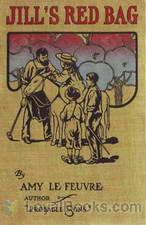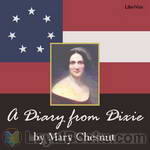|
Books Should Be Free Loyal Books Free Public Domain Audiobooks & eBook Downloads |
|
|
Books Should Be Free Loyal Books Free Public Domain Audiobooks & eBook Downloads |
|
Top Authors |
|---|
|
Book type:
Sort by:
|
By: Charlotte Mary Yonge (1823-1901) | |
|---|---|
 Modern Broods
Modern Broods
| |
 The Herd Boy and His Hermit
The Herd Boy and His Hermit
| |
 Dynevor Terrace: or, the clue of life — Volume 1
Dynevor Terrace: or, the clue of life — Volume 1
| |
By: Susan Glaspell (1876-1948) | |
|---|---|
 Trifles
Trifles
On the surface, this short play is a slice-of-life story about a murder investigation in the rural United States. However, it is also a story about the relationships between men and women, husbands and wives, and the often-overlooked "trifles" which can say so much about a person's life. | |
By: Amy le Feuvre (d.1929) | |
|---|---|
 Probable Sons
Probable Sons
Little Milly is left an orphan after the death of her mother and sent to live with her bachelor uncle, who has no use for children, especially of the female variety. As the days go by, his heart warms to his endearing niece who wants all probable sons to come home, including her very own probable uncle. | |
By: Susan Glaspell | |
|---|---|
 Fidelity
Fidelity
The small Midwestern town of Freeport was scandalized years ago when Ruth Holland, then a young girl, ran away to the West with a married man. Now that she's returned home to take care of her dying father, she faces some hard truths about who her true friends are and where her life is headed. | |
 Lifted Masks
Lifted Masks
In this collection of short stories, Susan Glaspell examines the unique character of America and its people. | |
By: Amy LeFeuvre (1861-1929) | |
|---|---|
 Teddy's Button
Teddy's Button
Teddy loves to tell the story of how his father heroically died on the battlefield and guards his button jealously. But this brings contention and strife when a new girl comes to town. Teddy begins to learn what it means to be a soldier under Christ, his Captain. | |
By: Amy Le Feuvre (1861-1929) | |
|---|---|
 Jill's Red Bag
Jill's Red Bag
Jack and Jill, along with their little sister "Bumps", are two pickles. Their curious, wild ways are too much for their guardians. But when their older sister reluctantly employs a governess for them, their feet are turned toward the "Golden City." | |
By: Susan Glaspell (1882-1948) | |
|---|---|
 The Glory of the Conquered The Story of a Great Love
The Glory of the Conquered The Story of a Great Love
| |
By: Amy Le Feuvre (1861-1929) | |
|---|---|
 His Big Opportunity
His Big Opportunity
Dudley and Rob were taught in Sunday School that they should use the opportunities God gives to help others. Ever since, they have been looking for 'their big opportunity' to do good for somebody. | |
By: Amy Le Feuvre (-1929) | |
|---|---|
 Dwell Deep or Hilda Thorn's Life Story
Dwell Deep or Hilda Thorn's Life Story
| |
By: Amy Le Feuvre (1861-1929) | |
|---|---|
 Carved Cupboard (Dramatic Reading)
Carved Cupboard (Dramatic Reading)
Agatha, Gwen, Clare and Elfie have always been told that they will inherit their aunt's house. But when their aunt dies, she leaves it all to their intolerable cousin James. What will they do? Will the verses Nannie gives them prove true? | |
 Odd
Odd
He found the word for her, and she read with difficulty, 'Trouble, distress, great affliction.' 'Do they all mean tribulation?' she asked. 'Tribulation means all of them,' was the answer. 'And can children have tribulation, Mr. Roper?' 'What do you think?' 'I must have it if I'm to get to heaven,' she said emphatically; and then she left him, and the young man repeated her words to himself with a sigh and a smile, as he replaced the book in its resting-place. Little Betty is lonely being the "odd" one ... | |
By: Amy Le Feuvre (-1929) | |
|---|---|
 'Me and Nobbles'
'Me and Nobbles'
| |
By: Susan Glaspell (1876-1948) | |
|---|---|
 Visioning , A Novel
Visioning , A Novel
"The Visioning, Susan Glaspell's second novel, tells about Katie Jones, a young woman who lives in the comfortable world she knows with a charming circle of friends. Her brother is an army officer, and her uncle lives in Washington. The world she knows is the world they let her see. Until Anne comes into the picture. Katie saves Anne from killing herself. Katie invents a story about Anne, a story which suits Katie's world, but what would she do, and feel, when she discovers the truth? The story focuses around Katie's eye opening experiences and her search for place and meaning in the new world she slowly discovers... | |
By: John Henry Patterson (1867-1947) | |
|---|---|
 The Man-Eaters of Tsavo and Other East African Adventures
The Man-Eaters of Tsavo and Other East African Adventures
In 1898, during the construction of river-crossing bridge for the Uganda Railway at the Tsavo River, as many as 135 railway workers were attacked at night, dragged into the wilderness, and devoured by two male lions. The Man-Eaters of Tsavo is the autobiographical account of Royal Engineer Lt. Col. J.H. Patterson's African adventures. Among them, his hunt for the two man-eaters.This book was the basis for the 1996 film The Ghost and the Darkness. | |
By: Harold Bell Wright (1872-1944) | |
|---|---|
 The Shepherd of the Hills
The Shepherd of the Hills
The story depicts the lives of mountain people living in the Ozarks and the mystery surrounding an old man called ‘The Shepherd of the Hills,’ who’s called Dad Howitt. The backdrop storyline surrounds the pretty Samantha Lane, called Sammy, and her love of Young Matt, Grant Matthews. The shepherd, an elderly, mysterious, learned man, escapes the buzzing restlessness of the city to live in the backwoods neighborhood of Mutton Hollow in the Ozark hills. | |
 That Printer of Udell's
That Printer of Udell's
| |
 Eyes Of The World
Eyes Of The World
The Eyes of the World was the Best Selling Book for 1914 according to Publisher's Weekly. The novel explores what Harold Bell Wright views as the false world of artists, writers, critics, and their wealthy patrons. Two of the main characters are the famous author, Conrad LaGrange and Aaron King, an aspiring artist. LaGrange regretfully describes his writings as “filthy stories in good English” and feels he has sold his soul to become successful. While in California, recovering from a physical breakdown, he befriends Aaron King whose mother he knew when he was a boy. Lagrange serves as counselor to the young man, for he knows the pitfalls of success from his own experience. | |
 The Winning of Barbara Worth
The Winning of Barbara Worth
| |
 Helen of the Old House
Helen of the Old House
| |
 The Calling of Dan Matthews
The Calling of Dan Matthews
| |
 When A Man's A Man
When A Man's A Man
| |
 The Re-Creation of Brian Kent
The Re-Creation of Brian Kent
| |
 The Uncrowned King
The Uncrowned King
| |
By: Charles McRae | |
|---|---|
 Fathers of Biology
Fathers of Biology
An account given of the lives of five great naturalists (Hippocrates, Aristotle, Galen, Vesalius and Harvey) will not be found devoid of interest. The work of each one of them marked a definite advance in the science of Biology. There is often among students of anatomy and physiology a tendency to imagine that the facts with which they are now being made familiar have all been established by recent observation and experiment. But even the slight knowledge of the history of Biology, which may be obtained from a perusal of this little book, will show that, so far from such being the case, this branch of science is of venerable antiquity... | |
By: Jane Addams (1860-1935) | |
|---|---|
 Twenty Years at Hull-House
Twenty Years at Hull-House
Jane Addams was the first American woman to be awarded the Nobel Peace Prize. In a long, complex career, she was a pioneer settlement worker and founder of Hull-House in Chicago, public philosopher (the first American woman in that role), author, and leader in woman suffrage and world peace. She was the most prominent woman of the Progressive Era and helped turn the nation to issues of concern to mothers, such as the needs of children, public health and world peace. She emphasized that women have a special responsibility to clean up their communities and make them better places to live, arguing they needed the vote to be effective... | |
 The Spirit of Youth and the City Streets
The Spirit of Youth and the City Streets
Much of the material in the following pages has appeared in current publications. It is here presented in book form in the hope that it may prove of value to those groups of people who in many cities are making a gallant effort to minimize the dangers which surround young people and to provide them with opportunities for recreation. (Introduction by Jane Addams) Jane Addams (1860 – 1935) was the first American woman to be awarded the Nobel Peace Prize. In a long, complex career, she was a pioneer settlement worker and founder of Hull House in Chicago, a public philosopher, a sociologist, an author and a spokesperson for women's suffrage and world peace. | |
 A New Conscience and an Ancient Evil
A New Conscience and an Ancient Evil
| |
 Democracy and Social Ethics
Democracy and Social Ethics
| |
By: Ezra Meeker (1830-1928) | |
|---|---|
 Ox-Team Days on the Oregon Trail
Ox-Team Days on the Oregon Trail
Ezra Meeker…was an early pioneer who traveled the Oregon Trail by ox cart as a young man. Beginning in his 70s, he worked tirelessly to memorialize the trail, repeatedly retracing the trip of his youth. This book is a memoir of those days. | |
By: Ouida (1839-1908) | |
|---|---|
 A Dog of Flanders
A Dog of Flanders
"Nello and Patrasche were left all alone in the world." So begins the poignant story of the two orphans who were to become inseparable companions. They were Nello, an orphaned youth, and Patrasche, the dog which he and his grandfather saved from near death one day. The tale takes place outside of Antwerp, and so popular has this story become that there is a commemorative statue of Nello and Patrasche standing in the village yet today. The story is powerful, and masterfully written by Marie Louise de la Ramée under the pseudonym Ouida. | |
By: Russel Doubleday (1872-1949) | |
|---|---|
 Stories of Inventors
Stories of Inventors
Doubleday chronicles the history of everyday inventions that form the foundation of technology now common through the world. While some of the inventions are no longer used, each example shows how inventors contributed to technology through perseverance, inspiration and clever observations. In each chapter, he gives a clear, understandable background of the technology.Many of the now outdated inventions may have inspired later inventions by meeting emerging demands. For example, Edison's filament bulb is now being phased out by more efficient CFL's, but Edison's contribution to indoor lighting likewise removed the need for inefficient gas-burning lamps... | |
By: Aleksandr Sergeevich Pushkin (1799-1837) | |
|---|---|
 Eugene Oneguine [Onegin] A Romance of Russian Life in Verse
Eugene Oneguine [Onegin] A Romance of Russian Life in Verse
| |
 The Queen Of Spades
The Queen Of Spades
| |
 Boris Godunov: a drama in verse
Boris Godunov: a drama in verse
| |
By: Alexander Pushkin (1799-1837) | |
|---|---|
 Daughter of the Commandant
Daughter of the Commandant
"The Daughter of the Commandant" (better known as "The Captain's Daughter") is a historical novel by the Russian writer Alexander Pushkin, and is considered to be his finest prose work. The novel is a romanticized account of Pugachev's Rebellion in 1773-1774. The 17-year-old Pyotr Andreyich is sent by his father to military service in a remote Russian outpost, where he leans honor and love while being caught up in a violent uprising of tribal groups against the imperial government. | |
By: Aleksandr Sergeevich Pushkin (1799-1837) | |
|---|---|
 Marie; a story of Russian love
Marie; a story of Russian love
| |
By: John Dewey (1859-1952) | |
|---|---|
 Democracy and Education: an introduction to the philosophy of education
Democracy and Education: an introduction to the philosophy of education
| |
 The Child and the Curriculum
The Child and the Curriculum
| |
 Moral Principles in Education
Moral Principles in Education
| |
 How We Think
How We Think
A book written by an American education philosopher in which he proposed “This scientific attitude of mind might, conceivably, be quite irrelevant to teaching children and youth. But this book also represents the conviction that such is not the case; that the native and unspoiled attitude of childhood, marked by ardent curiosity, fertile imagination, and love of experimental inquiry, is near, very near, to the attitude of the scientific mind. If these pages assist any to appreciate this kinship and to consider seriously how its recognition in educational practice would make for individual happiness and the reduction of social waste, ... | |
 Letters from China and Japan
Letters from China and Japan
| |
 China, Japan and the U.S.A. Present-Day Conditions in the Far East and Their Bearing on the Washington Conference
China, Japan and the U.S.A. Present-Day Conditions in the Far East and Their Bearing on the Washington Conference
| |
By: Mary E. Hanshew (1852-1927) and Thomas W. Hanshew (1857-1914) | |
|---|---|
 The Riddle of the Frozen Flame
The Riddle of the Frozen Flame
Another full-length mystery story featuring Hamilton Cleek, whom we met first in Cleek: The Man of the Forty Faces. This time, Cleek investigates the sinister disappearance of people and the mysterious appearance of flames at night in the desolate Fens, and his friend Superintendent Narkom of Scotland Yard tries to solve some tricky cases of bank robberies in London.While not quite up to the standard we have come to expect from previous Cleek adventures, it is still quite a jolly romp, and Cleek's cockney sidekick Dollops is always good fun. | |
By: William Bligh (1754-1817) | |
|---|---|
 A Voyage to the South Sea
A Voyage to the South Sea
A Voyage to the South Sea, undertaken by command of His Majesty, for the purpose of conveying the Bread-fruit tree to the West Indies, in His Majesty’s ship The Bounty, commanded by Lieutenant William Bligh. Including an account of the Mutiny on board the said ship, and the subsequent voyage of part of the crew, in the ship’s boat, from Tofoa, one of the Friendly Islands, to Timor, a Dutch settlement in the East Indies. | |
 A Narrative Of The Mutiny, On Board His Majesty's Ship Bounty; And The Subsequent Voyage Of Part Of The Crew, In The Ship's Boat
A Narrative Of The Mutiny, On Board His Majesty's Ship Bounty; And The Subsequent Voyage Of Part Of The Crew, In The Ship's Boat
| |
By: Mary Chesnut | |
|---|---|
 A Diary from Dixie
A Diary from Dixie
Mary Boykin Miller Chesnut, a well-educated South Carolina woman who was the wife of a Confederate general, kept extensive journals during the Civil War. Mrs. Chesnut moved in elite circles of Southern society and had a keen interest in politics. Her diary is both an important historic document and, due to her sharp wit and often irreverent attitude, a fascinating window into Southern society of the time. This recording is of the first published edition of the diary, compiled from Mrs. Chesnut's revisions of her original journals. | |
By: Elisha Gray (1835-1901) | |
|---|---|
 Nature's Miracles: Familiar Talks on Science
Nature's Miracles: Familiar Talks on Science
Elisha Gray (August 2, 1835 – January 21, 1901) was an American electrical engineer who co-founded the Western Electric Manufacturing Company. Gray is best known for his development of a telephone prototype in 1876 in Highland Park, Illinois and is considered by some writers to be the true inventor of the variable resistance telephone, despite losing out to Alexander Graham Bell for the telephone patent. | |
By: Lady Mary Wroth (1587-1651/3) | |
|---|---|
 Pamphilia to Amphilanthus
Pamphilia to Amphilanthus
Pamphilia to Amphilanthus is the first sonnet sequence written by an Englishwoman. Published in 1621, the poems invert the usual format of sonnet sequences by making the speaker a woman (Pamphilia, whose name means “all-loving”) and the beloved a man (Amphilanthus, whose name means “lover of two.”). It is possible that Wroth based the story on her own fraught relationship with her cousin, William Herbert. | |
By: Jaques Futrelle (1875-1912) | |
|---|---|
 The Diamond Master
The Diamond Master
A perfect diamond worth millions is mailed, in a plain package, to a diamond dealer. Then he finds that identical diamonds were delivered to other diamond dealers. Where did the gems come from? Who sent them? And why? (Introduction by Dawn) | |
By: Frederick Starr (1858-1933) | |
|---|---|
 A Little Book of Filipino Riddles
A Little Book of Filipino Riddles
| |
 American Indians
American Indians
| |